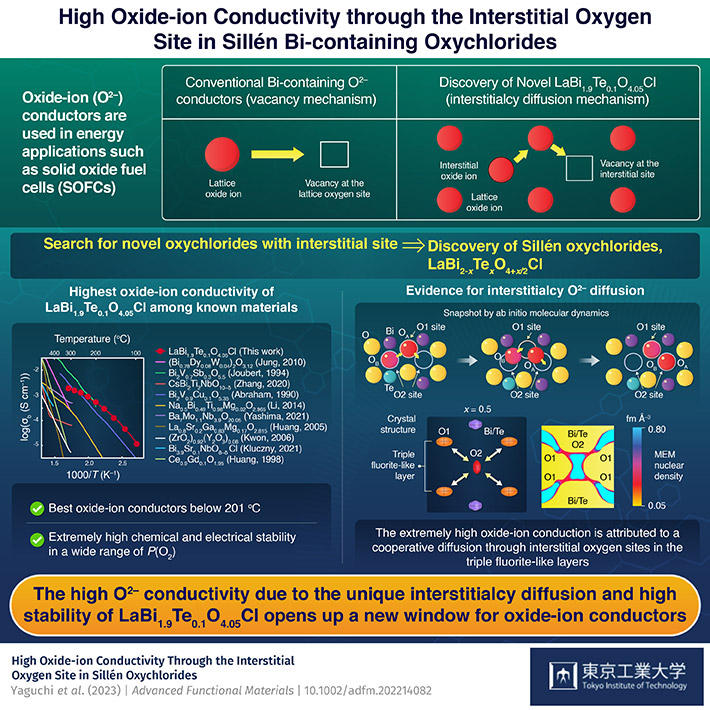Solid oxide fuel cells (SOFCs) are a promising solution to the contemporary problem of the impending global energy crisis. SOFCs show high efficiency, lower emissions, and have low operating costs, making them an ideal power source for a fossil fuel-free society.
Conventional SOFCs with yttria-stabilized zirconia (YSZ) electrolytes have high operating temperatures (700—1,000℃), and their widespread adoption has been limited by their degradation issues and high cost. Therefore, there is a need to search for new materials exhibiting high conductivities and stability at low temperatures (100—300℃). While some bismuth(Bi)-containing materials exhibit high oxide-ion conductivities through the conventional vacancy diffusion mechanism, they are not very stable under reduced atmospheres. As an alternative, the interstitialcy migration mechanism, involving the knock-on motion of interstitial and lattice oxide ions, has attracted much attention. However, they are rarely observed in Bi-containing materials.
A team of researchers from Japan led by Prof. Masatomo Yashima of Tokyo Institute of Technology (Tokyo Tech) put their heads together to find a solution to these problems. In their recent breakthrough published in Advanced Functional Materials, the team reported a new Bi-containing compound, LaBi1.9Te0.1O4.05Cl, where the oxide ions migrate via the interstitialcy mechanism. The team demonstrated that LaBi1.9Te0.1O4.05Cl exhibits both high stability and a high oxide-ion conductivity that is superior to those of even the best oxide-ion conductors at low temperatures (below 201℃).
When asked how the team was able to discover LaBi1.9Te0.1O4.05Cl, Prof. Yashima explains, "Most known Bi-containing materials exhibit high oxide-ion conductivities via the conventional vacancy diffusion mechanism. The alternative mechanism, interstitialcy diffusion, is rare in these materials. Thus, we specifically searched for Bi-containing materials with interstitial oxygen site that could enable the interstitialcy diffusion."
The interstitial oxygen site refers to the empty space within a crystal structure where the oxide ions partially occupy. Prof. Yashima's group selected a Bi-containing Sillén oxychloride, LaBi2O4Cl, with a triple fluorite-like layer to ensure the presence of such interstitial oxygen sites. They then partially substituted the Bi3+ cation with a high valence dopant, tellurium (Te) cation Te4+, in the Sillén phase LaBi2O4Cl to increase the amount of interstitial oxygen atoms (x/2) in LaBi2–xTexO4+x/2Cl. The chemical composition, LaBi1.9Te0.1O4.05Cl (x = 0.1 in LaBi1–xTexO4+x/2Cl), was then chosen for detailed experimental and computational studies since the bulk conductivity of LaBi1.9Te0.1O4.05Cl was the highest among those of all the other compositions, i.e., LaBi2–xTexO4+x/2Cl (0 ≤ x ≤ 0.2).
The team found that LaBi1.9Te0.1O4.05Cl exhibits high chemical and electrical stability at 400℃ in a wide oxygen partial pressure region between 10−25 to 0.2 atm, as well as a high chemical stability in CO2, wet H2 in N2, and air with natural humidity. Further, LaBi1.9Te0.1O4.05Cl demonstrated a high oxide-ion conductivity of 2.0 × 10−2 S cm−1 at 702℃. The bulk conductivity of the material was significantly higher than those of the best oxide-ion conductors such as Bi2V0.9Cu0.1O5.35 at temperatures between 96—201℃.
To elucidate the mechanism underlying the high oxide-ion conduction, the team performed neutron-diffraction experiments, ab initio molecular dynamics simulations, and DFT calculations. The results indicated that the extremely high oxide-ion conduction is explained by an interstitialcy migration of oxide ions through the lattice and interstitial sites, which is a rare occurrence in Bi-containing materials.
The discovery of the high oxide ionic conductivity along with high chemical and electrical stability of LaBi1.9Te0.1O4.05Cl, and the unique mechanism underlying the high conductivity will open door to further research on Bi-containing compounds and Sillén phases, and eventually to high-performance SOFC electrolytes at low temperatures. "There were studies on the photocatalysis and luminescence of Sillén phases in the research literature. In our study, we have now demonstrated that Sillén Bi-containing oxychlorides can also act as promising electrolytes for SOFCs and could contribute to the fuel cell revolution," concludes an optimistic Prof. Yashima.
. Any information published on this site will be valid in relation to Science Tokyo.




